bus AUDI A8 2003 D3 / 2.G Technical Features Manual
[x] Cancel search | Manufacturer: AUDI, Model Year: 2003, Model line: A8, Model: AUDI A8 2003 D3 / 2.GPages: 96, PDF Size: 5.51 MB
Page 62 of 96
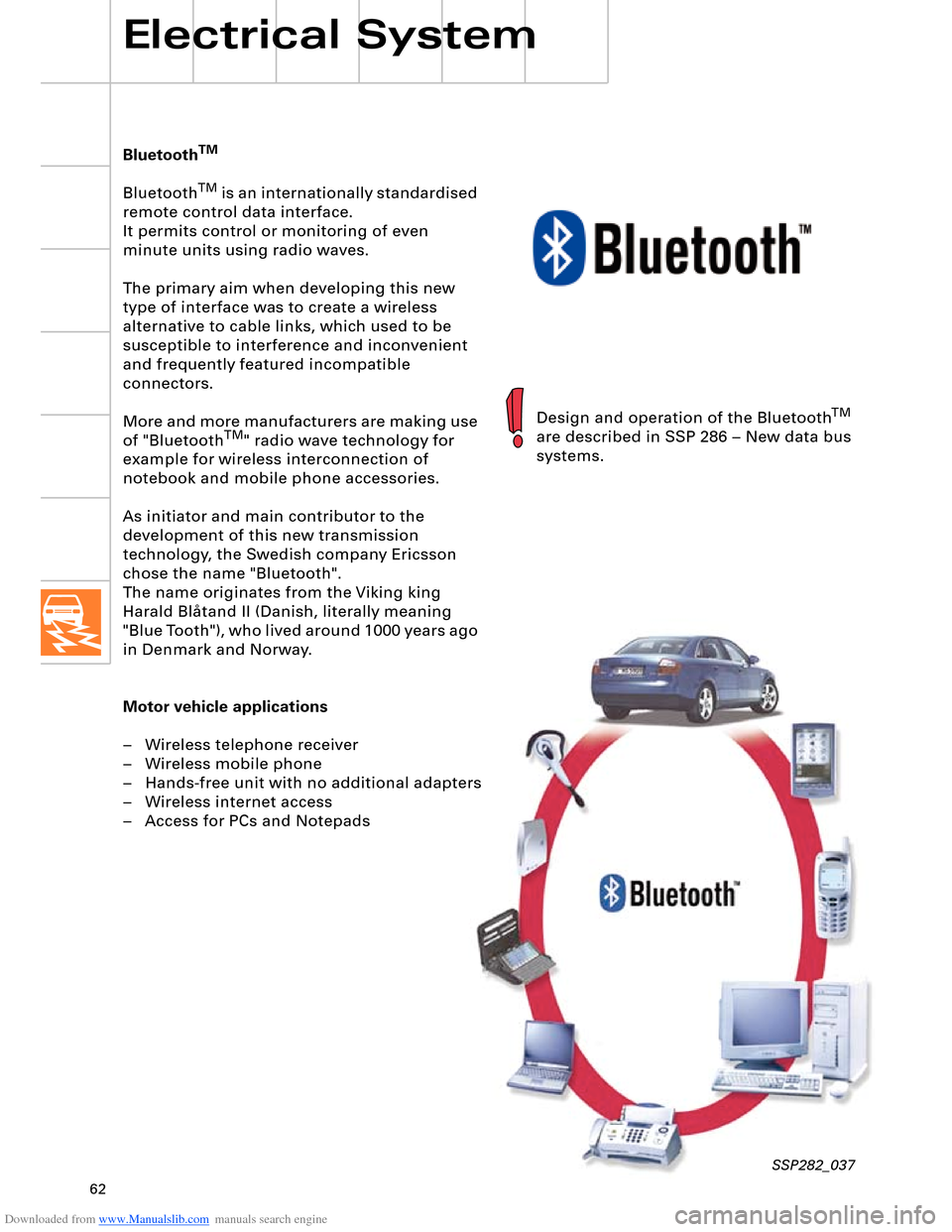
Downloaded from www.Manualslib.com manuals search engine 62
Electrical System
BluetoothTM
BluetoothTM is an internationally standardised
remote control data interface.
It permits control or monitoring of even
minute units using radio waves.
The primary aim when developing this new
type of interface was to create a wireless
alternative to cable links, which used to be
susceptible to interference and inconvenient
and frequently featured incompatible
connectors.
More and more manufacturers are making use
of "Bluetooth
TM" radio wave technology for
example for wireless interconnection of
notebook and mobile phone accessories.
As initiator and main contributor to the
development of this new transmission
technology, the Swedish company Ericsson
chose the name "Bluetooth".
The name originates from the Viking king
Harald Blåtand II (Danish, literally meaning
"Blue Tooth"), who lived around 1000 years ago
in Denmark and Norway.
Motor vehicle applications
– Wireless telephone receiver
– Wireless mobile phone
– Hands-free unit with no additional adapters
– Wireless internet access
– Access for PCs and Notepads
SSP282_037
Design and operation of the BluetoothTM
are described in SSP 286 – New data bus
systems.
Page 63 of 96
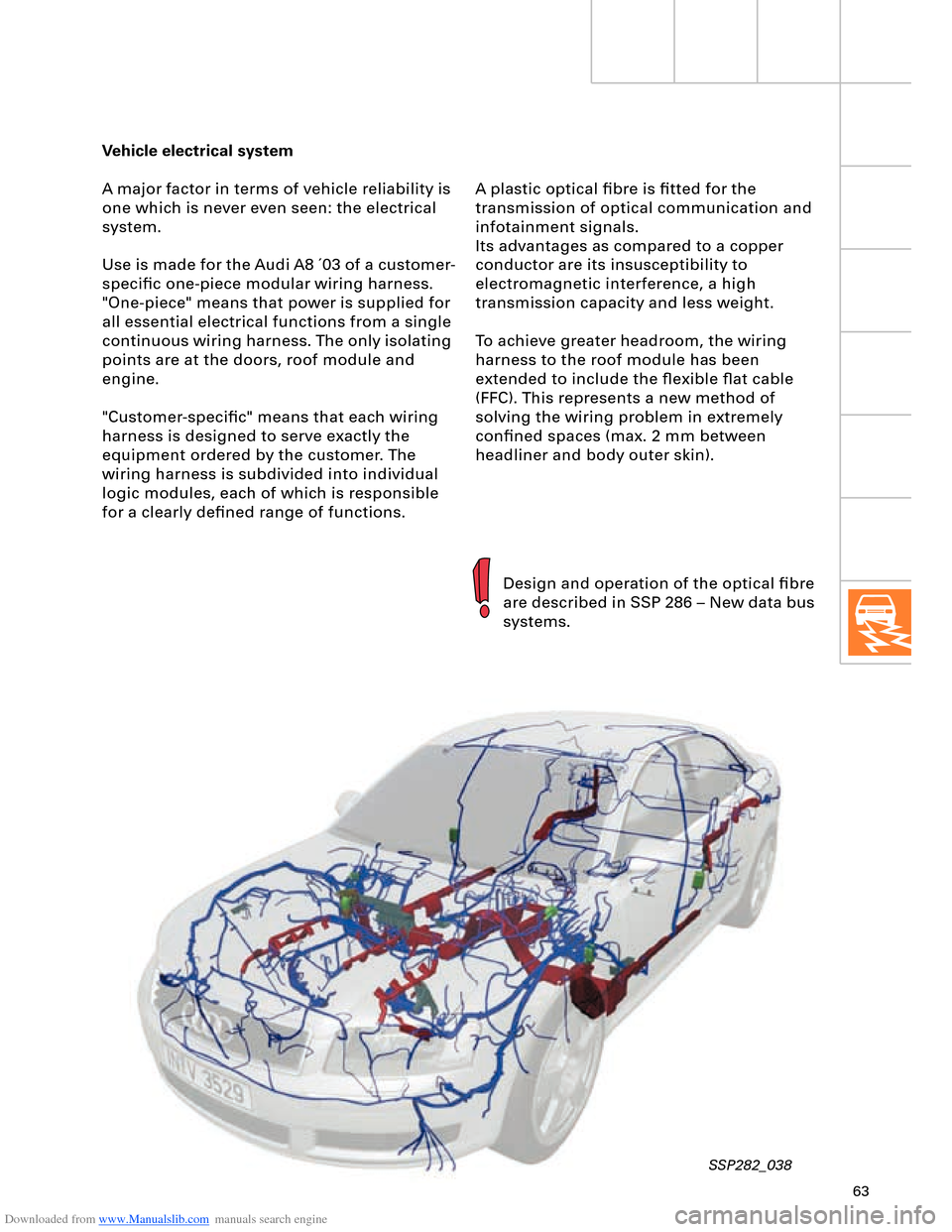
Downloaded from www.Manualslib.com manuals search engine 63
Vehicle electrical system
A major factor in terms of vehicle reliability is
one which is never even seen: the electrical
system.
Use is made for the Audi A8 ´03 of a customer-
specific one-piece modular wiring harness.
"One-piece" means that power is supplied for
all essential electrical functions from a single
continuous wiring harness. The only isolating
points are at the doors, roof module and
engine.
"Customer-specific" means that each wiring
harness is designed to serve exactly the
equipment ordered by the customer. The
wiring harness is subdivided into individual
logic modules, each of which is responsible
for a clearly defined range of functions.
SSP282_038
Design and operation of the optical fibre
are described in SSP 286 – New data bus
systems. A plastic optical fibre is fitted for the
transmission of optical communication and
infotainment signals.
Its advantages as compared to a copper
conductor are its insusceptibility to
electromagnetic interference, a high
transmission capacity and less weight.
To achieve greater headroom, the wiring
harness to the roof module has been
extended to include the flexible flat cable
(FFC). This represents a new method of
solving the wiring problem in extremely
confined spaces (max. 2 mm between
headliner and body outer skin).
Page 66 of 96
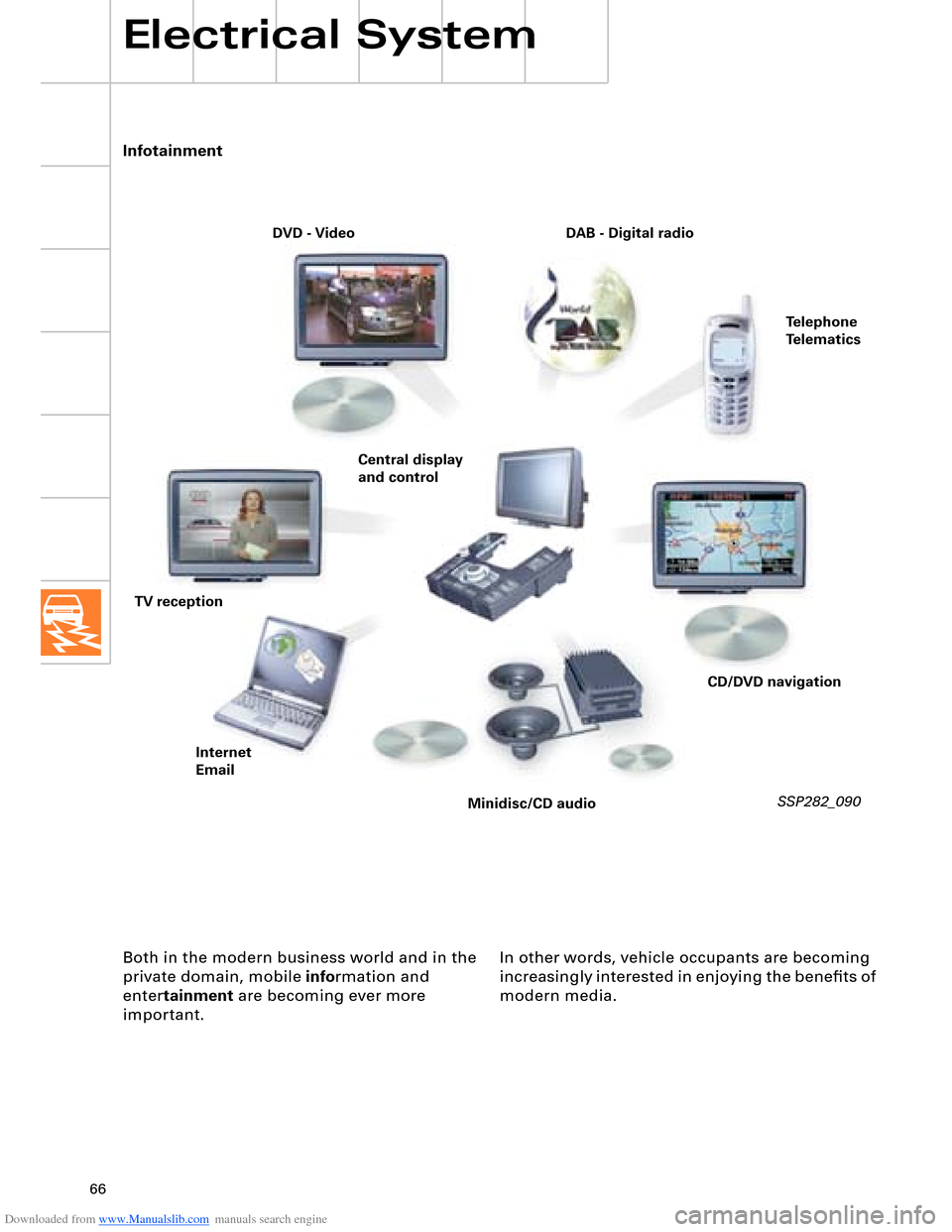
Downloaded from www.Manualslib.com manuals search engine 66
Electrical System
Both in the modern business world and in the
private domain, mobile information and
entertainment are becoming ever more
important. In other words, vehicle occupants are becoming
increasingly interested in enjoying the benefits of
modern media.
SSP282_090
Infotainment
DVD - Video
TV reception
Minidisc/CD audio Internet
EmailTelephone
Telematics DAB - Digital radio
CD/DVD navigation Central display
and control
Page 73 of 96

Downloaded from www.Manualslib.com manuals search engine 7374
A distinction is made between two air
conditioner unit versions
– 2-zone front and rear climate
control
– 4-zone front and rear climate
control
and three types of control and
display unit
– Air conditioner control panel with
no seat heating/ventilation
– Air conditioner control panel with
seat heating
– Air conditioner control panel with
seat heating and seat ventilation
(identified by part number index).
SSP282_099
Self-diagnosis
Fault diagnosis and measured value blocks
for air conditioner and seat heating system
can be read out by way of address words 08
"Air conditioner/heater electronics" and 28
"Rear climate control". The functions of and
exact procedure for self-diagnosis and
assisted fault-finding with VAS 5051 can be
found in the Heating/Air Conditioner
Workshop Manual for the relevant vehicle
model.
Operating principle
When the ignition is switched on, the
Climatronic control unit J255 starts up with
the same temperature, air distribution and
fresh-air blower speed settings etc. as were
applicable the last time the ignition was
switched off by way of the appropriate key or
using fingerprint recognition.
If fingerprint recognition has been
implemented, this has priority over key
recognition (refer also to SSP 287 – Audi A8 ´03
Electrical Components).
Personalised settings
The following settings can be made for each
climate control zone (front left, right and,
optionally, with 4-zone climate control rear left
and right):
– Left/right temperature
– Air flow
– Left/right air distribution
– Left/right seat heating
– Left/right seat ventilation
– Operating modes (AUTO for driver and front
passenger, temperature-adjustable centre
vents, automatically controlled
recirculated-air mode, ECON)
The heated windscreen can be activated by
way of the air conditioner defrost button or
the air conditioner control unit automatically
switches on the electric heated windscreen if
the appropriate conditions are satisfied
(windscreen defrost or automatic mode on
cold starting).
The Climatronic J255 and heated windscreen
J505 control units communicate by way of the
LIN bus. The Climatronic control unit transmits
the specified windscreen heating power to the
heated windscreen control unit on the LIN bus.
Heating/Air Conditioner
Key recognition takes place in the case of
remote control (radio or key transponder),
with the driver identification control unit
providing the Climatronic control unit J255
with the appropriate information by way of
the CAN bus.
The electrically heated windscreen is only
supplied with the amount of power which can
currently be drawn from the electrical system
without draining the battery. This is
monitored by the energy management
control unit J644.
As is the case with the Audi A4, the
windscreen is heated by applying voltage to a
metallic foil fitted in the glass (refer to
SSP 213).
As in the Audi A4, the air conditioner
compressor is regulated as a function of load
and controlled externally by way of the
compressor regulating valve (refer to
SSP 240). The Climatronic control unit J255 is
connected to the convenience CAN, via
which diagnosis is also performed.
A manual air conditioning system is not
available.
Page 80 of 96

Downloaded from www.Manualslib.com manuals search engine 80
Heating/Air Conditioner
SSP282_103 Fresh-air intake duct
temperature sensor G89
Flap control
motor potentiometers
G92, G113, G135, G136,
G137, G138, G139, G140,
G143, G317, G318, G349,
G350, G351, G352
Air quality sensor G238
Left/right vent temperature
sender G150/G151
Centre vent temperature
sender G191
Evaporator outflow temperature
sender G263
High-pressure sender G65
Sunlight penetration
photosensor G107
Solar cells in sunroof C20
System layoutControl unit with display
in dash panel insert J285
MOST busFront information display and
operating unit control unit J523
Rear right footwell heater
element Z43 Rear left footwell heater
element Z42 Fresh-air blower control unit
J126 with fresh-air blower V2Diagnosis CAN
Data bus diagnostic
interface J533
Sunroof electronics
control unit J528 Humidity
sender G355
Humidity sender
heater N340
Climatronic
control unit J255
Convenience CAN
Additional heater
control unit J364 Rear Climatronic control
and display unit E265Energy management
control unit J644Drive system CANEngine control unit J623Front information and display and
operating unit control unit J685
Radiator fan
control unit J293
Radiator fan V7
Air conditioning system compressor regulating valve N280
Flap control motors
V68, V71, V102, V107, V108, V109,
V110, V111, V113, V199, V200, V220,
V218, V219, V221
Coolant circulation pump V50
Left/right heat regulation valve N175/N176
Heated windscreen control unit J505
Heated windscreen Z2
Driver seat/front passenger seat ventilation control unit
J672/J673
Front left/front right heated seat Z45/Z46
Temperature sender for front left/front right seat
G344/G345
Page 81 of 96
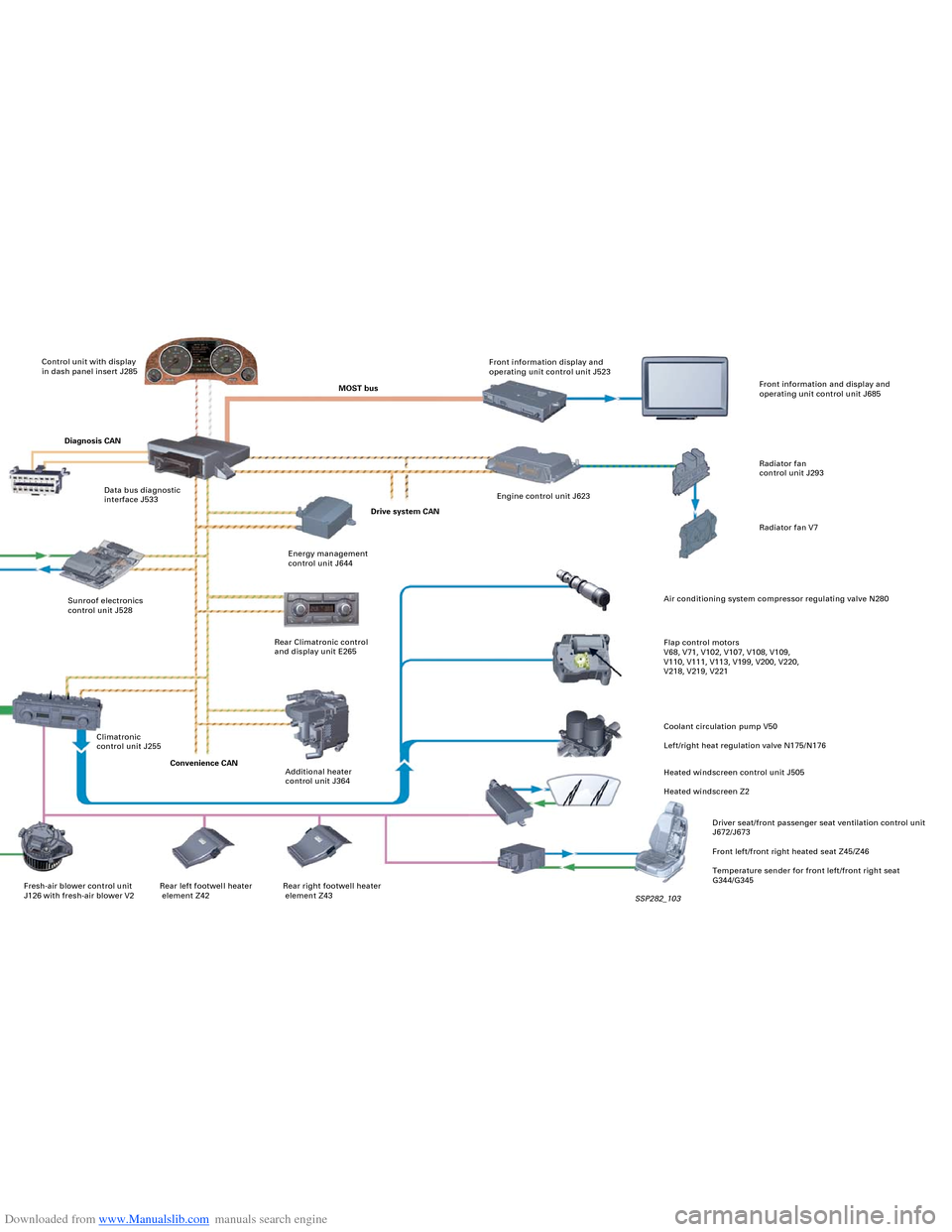
Downloaded from www.Manualslib.com manuals search engine 80
Heating/Air Conditioner
SSP282_103 Fresh-air intake duct
temperature sensor G89
Flap control
motor potentiometers
G92, G113, G135, G136,
G137, G138, G139, G140,
G143, G317, G318, G349,
G350, G351, G352
Air quality sensor G238
Left/right vent temperature
sender G150/G151
Centre vent temperature
sender G191
Evaporator outflow temperature
sender G263
High-pressure sender G65
Sunlight penetration
photosensor G107
Solar cells in sunroof C20
System layoutControl unit with display
in dash panel insert J285
MOST busFront information display and
operating unit control unit J523
Rear right footwell heater
element Z43 Rear left footwell heater
element Z42 Fresh-air blower control unit
J126 with fresh-air blower V2Diagnosis CAN
Data bus diagnostic
interface J533
Sunroof electronics
control unit J528 Humidity
sender G355
Humidity sender
heater N340
Climatronic
control unit J255
Convenience CAN
Additional heater
control unit J364 Rear Climatronic control
and display unit E265Energy management
control unit J644Drive system CANEngine control unit J623Front information and display and
operating unit control unit J685
Radiator fan
control unit J293
Radiator fan V7
Air conditioning system compressor regulating valve N280
Flap control motors
V68, V71, V102, V107, V108, V109,
V110, V111, V113, V199, V200, V220,
V218, V219, V221
Coolant circulation pump V50
Left/right heat regulation valve N175/N176
Heated windscreen control unit J505
Heated windscreen Z2
Driver seat/front passenger seat ventilation control unit
J672/J673
Front left/front right heated seat Z45/Z46
Temperature sender for front left/front right seat
G344/G345
Page 86 of 96
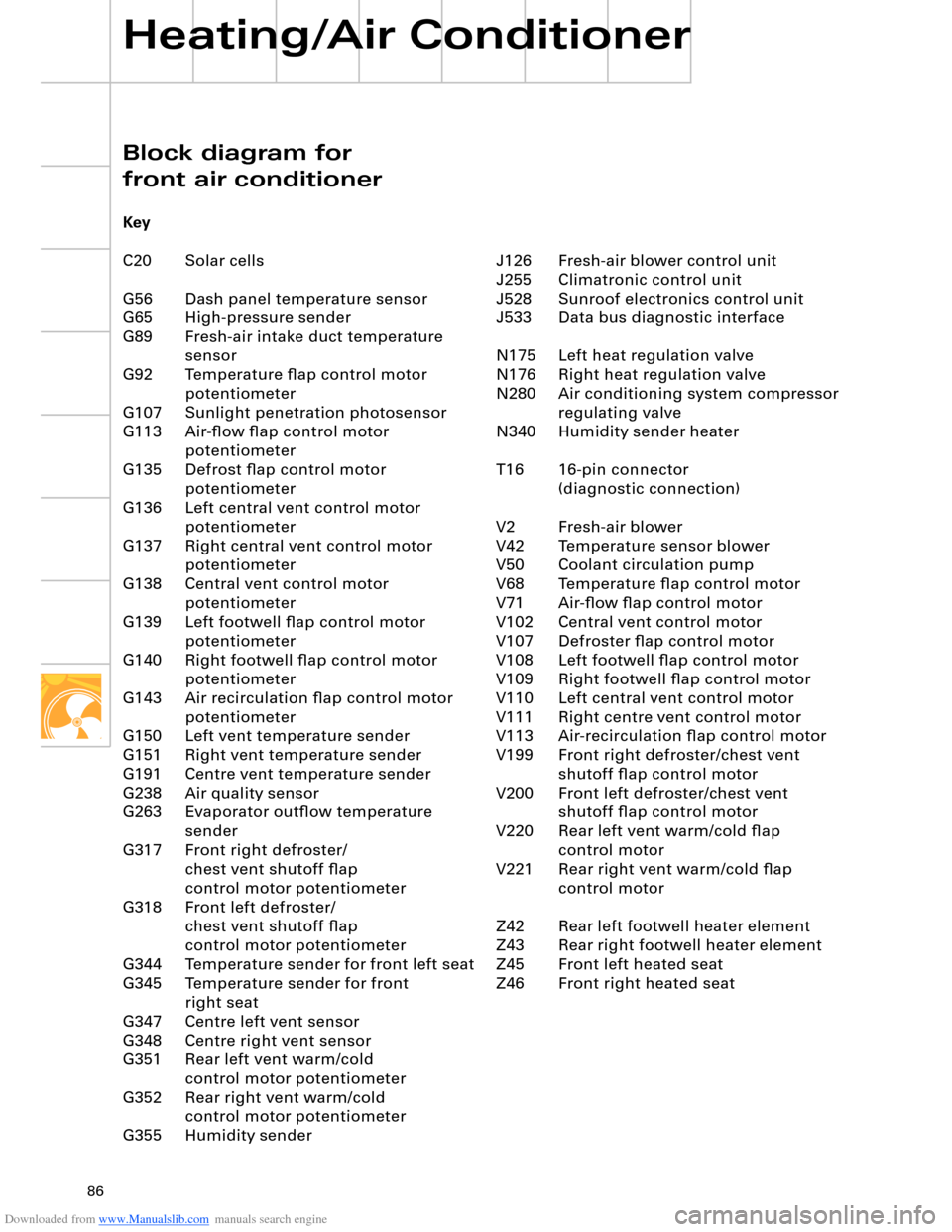
Downloaded from www.Manualslib.com manuals search engine 86
J126 Fresh-air blower control unit
J255 Climatronic control unit
J528 Sunroof electronics control unit
J533 Data bus diagnostic interface
N175 Left heat regulation valve
N176 Right heat regulation valve
N280 Air conditioning system compressor
regulating valve
N340 Humidity sender heater
T16 16-pin connector
(diagnostic connection)
V2 Fresh-air blower
V42 Temperature sensor blower
V50 Coolant circulation pump
V68 Temperature flap control motor
V71 Air-flow flap control motor
V102 Central vent control motor
V107 Defroster flap control motor
V108 Left footwell flap control motor
V109 Right footwell flap control motor
V110 Left central vent control motor
V111 Right centre vent control motor
V113 Air-recirculation flap control motor
V199 Front right defroster/chest vent
shutoff flap control motor
V200 Front left defroster/chest vent
shutoff flap control motor
V220 Rear left vent warm/cold flap
control motor
V221 Rear right vent warm/cold flap
control motor
Z42 Rear left footwell heater element
Z43 Rear right footwell heater element
Z45 Front left heated seat
Z46 Front right heated seat
Block diagram for
front air conditioner
Key
C20 Solar cells
G56 Dash panel temperature sensor
G65 High-pressure sender
G89 Fresh-air intake duct temperature
sensor
G92 Temperature flap control motor
potentiometer
G107 Sunlight penetration photosensor
G113 Air-flow flap control motor
potentiometer
G135 Defrost flap control motor
potentiometer
G136 Left central vent control motor
potentiometer
G137 Right central vent control motor
potentiometer
G138 Central vent control motor
potentiometer
G139 Left footwell flap control motor
potentiometer
G140 Right footwell flap control motor
potentiometer
G143 Air recirculation flap control motor
potentiometer
G150 Left vent temperature sender
G151 Right vent temperature sender
G191 Centre vent temperature sender
G238 Air quality sensor
G263 Evaporator outflow temperature
sender
G317 Front right defroster/
chest vent shutoff flap
control motor potentiometer
G318 Front left defroster/
chest vent shutoff flap
control motor potentiometer
G344 Temperature sender for front left seat
G345 Temperature sender for front
right seat
G347 Centre left vent sensor
G348 Centre right vent sensor
G351 Rear left vent warm/cold
control motor potentiometer
G352 Rear right vent warm/cold
control motor potentiometer
G355 Humidity sender
Heating/Air Conditioner
Page 87 of 96
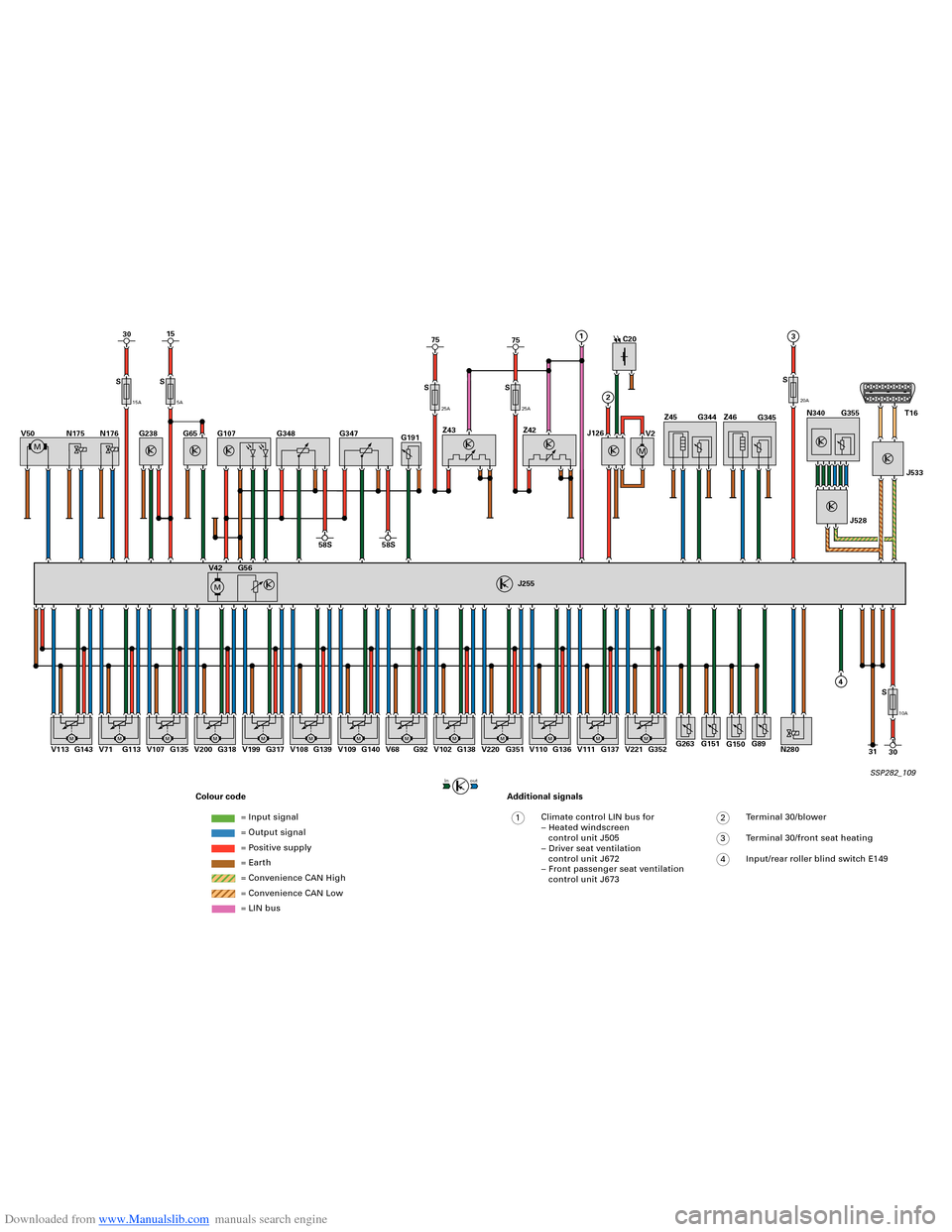
Downloaded from www.Manualslib.com manuals search engine M
MMMMMMMMMMMMM
M
V50 N175 N176G238 G65 G107 G348 G347Z43 Z42
J126
V2Z45 G344 Z46
G345 3015
SS
15A5A
75
S
25A
75
S
25A
C20
S
20A
N340G355
J528J533
S
10A
30
G89
G150 G151 G263
V221
V111 V110 V220
V102 V68 V109 V108 V199 V200 V107 V71 V113J255 V42 G5658S
58S
G143G113 G135
G318G317G139
G140G92
G138G351G136
G137G35231
inout
2
31
4
G191
N280
M
T16
Colour code
= Input signal
= Output signal
= Positive supply
= Earth
= Convenience CAN High
= Convenience CAN Low
= LIN busAdditional signals
Climate control LIN bus for
– Heated windscreen
control unit J505
– Driver seat ventilation
control unit J672
– Front passenger seat ventilation
control unit J673
1Terminal 30/blower
Terminal 30/front seat heating
Input/rear roller blind switch E1492
3
4
SSP282_109
Page 89 of 96
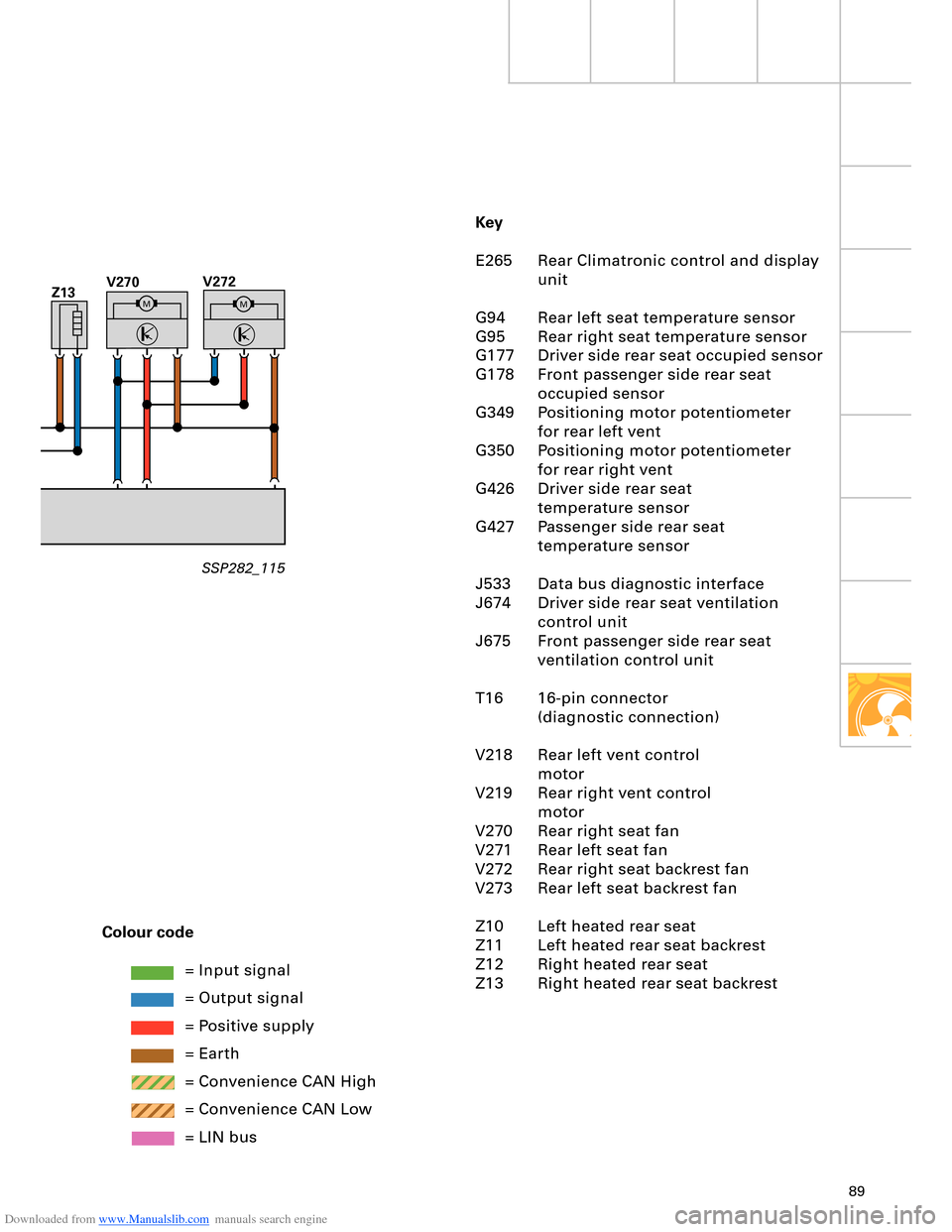
Downloaded from www.Manualslib.com manuals search engine 89
Key
E265 Rear Climatronic control and display
unit
G94 Rear left seat temperature sensor
G95 Rear right seat temperature sensor
G177 Driver side rear seat occupied sensor
G178 Front passenger side rear seat
occupied sensor
G349 Positioning motor potentiometer
for rear left vent
G350 Positioning motor potentiometer
for rear right vent
G426 Driver side rear seat
temperature sensor
G427 Passenger side rear seat
temperature sensor
J533 Data bus diagnostic interface
J674 Driver side rear seat ventilation
control unit
J675 Front passenger side rear seat
ventilation control unit
T16 16-pin connector
(diagnostic connection)
V218 Rear left vent control
motor
V219 Rear right vent control
motor
V270 Rear right seat fan
V271 Rear left seat fan
V272 Rear right seat backrest fan
V273 Rear left seat backrest fan
Z10 Left heated rear seat
Z11 Left heated rear seat backrest
Z12 Right heated rear seat
Z13 Right heated rear seat backrest Colour code
= Input signal
= Output signal
= Positive supply
= Earth
= Convenience CAN High
= Convenience CAN Low
= LIN bus
Z13V272MM
V270
SSP282_115
Page 90 of 96
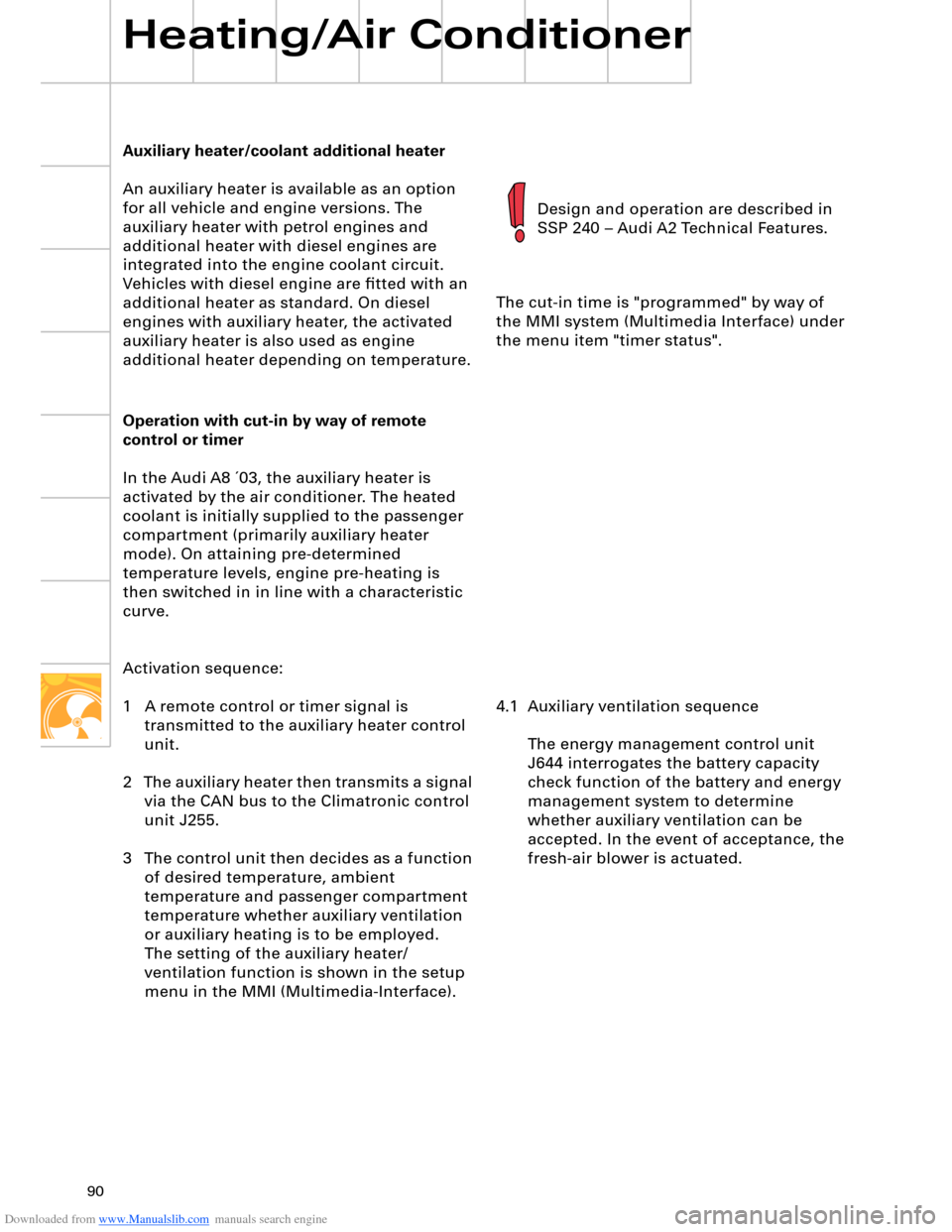
Downloaded from www.Manualslib.com manuals search engine 90
Auxiliary heater/coolant additional heater
An auxiliary heater is available as an option
for all vehicle and engine versions. The
auxiliary heater with petrol engines and
additional heater with diesel engines are
integrated into the engine coolant circuit.
Vehicles with diesel engine are fitted with an
additional heater as standard. On diesel
engines with auxiliary heater, the activated
auxiliary heater is also used as engine
additional heater depending on temperature.
Heating/Air Conditioner
Design and operation are described in
SSP 240 – Audi A2 Technical Features.
Operation with cut-in by way of remote
control or timer
In the Audi A8 ´03, the auxiliary heater is
activated by the air conditioner. The heated
coolant is initially supplied to the passenger
compartment (primarily auxiliary heater
mode). On attaining pre-determined
temperature levels, engine pre-heating is
then switched in in line with a characteristic
curve.
Activation sequence:
1 A remote control or timer signal is
transmitted to the auxiliary heater control
unit.
2 The auxiliary heater then transmits a signal
via the CAN bus to the Climatronic control
unit J255.
3 The control unit then decides as a function
of desired temperature, ambient
temperature and passenger compartment
temperature whether auxiliary ventilation
or auxiliary heating is to be employed.
The setting of the auxiliary heater/
ventilation function is shown in the setup
menu in the MMI (Multimedia-Interface).The cut-in time is "programmed" by way of
the MMI system (Multimedia Interface) under
the menu item "timer status".
4.1 Auxiliary ventilation sequence
The energy management control unit
J644 interrogates the battery capacity
check function of the battery and energy
management system to determine
whether auxiliary ventilation can be
accepted. In the event of acceptance, the
fresh-air blower is actuated.